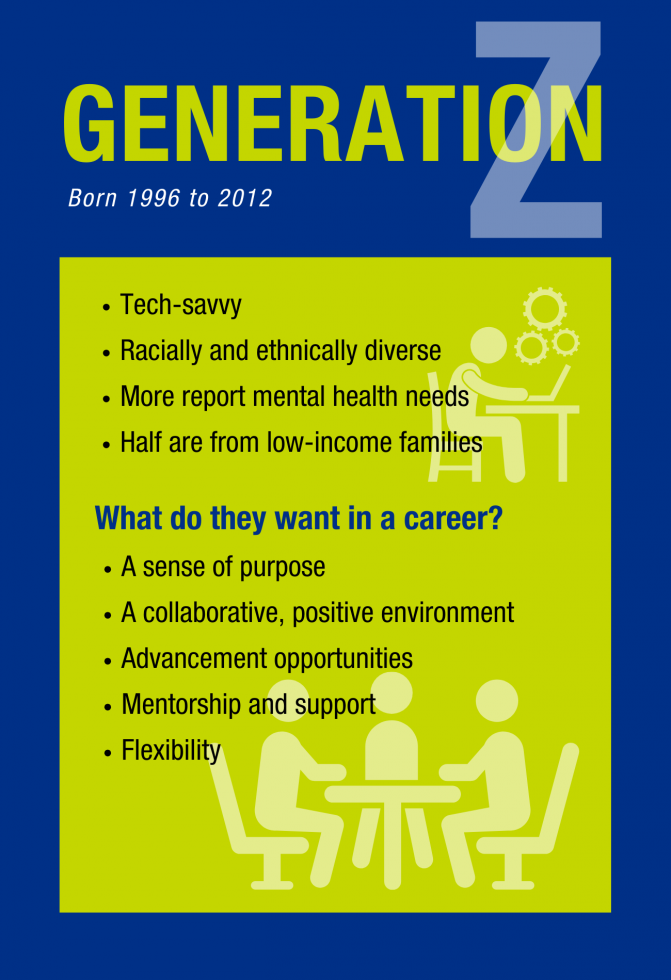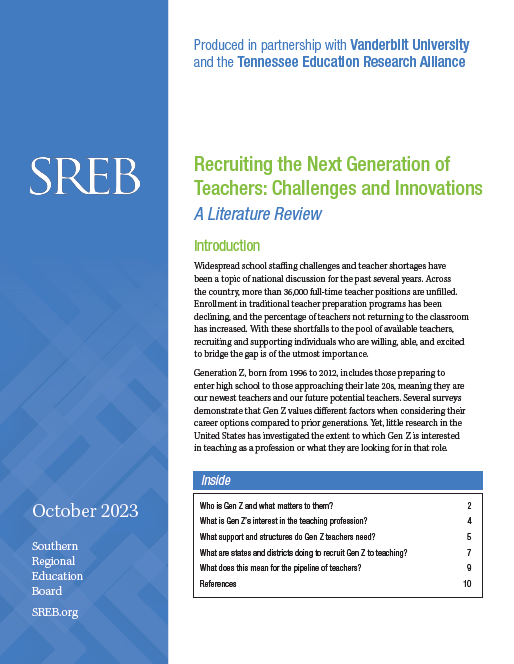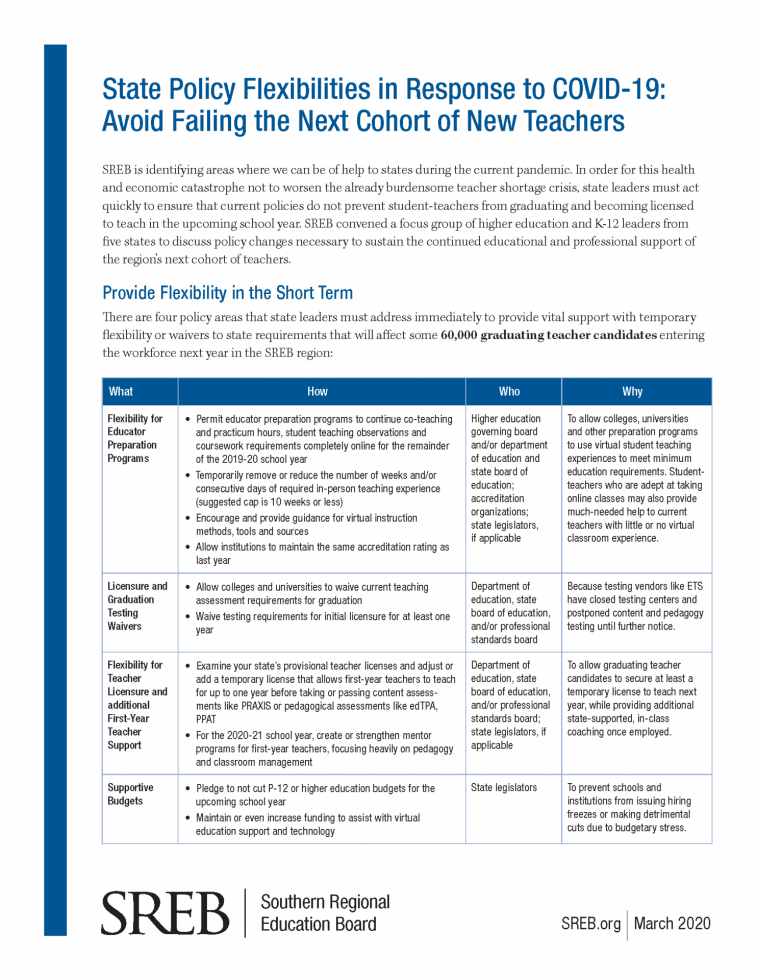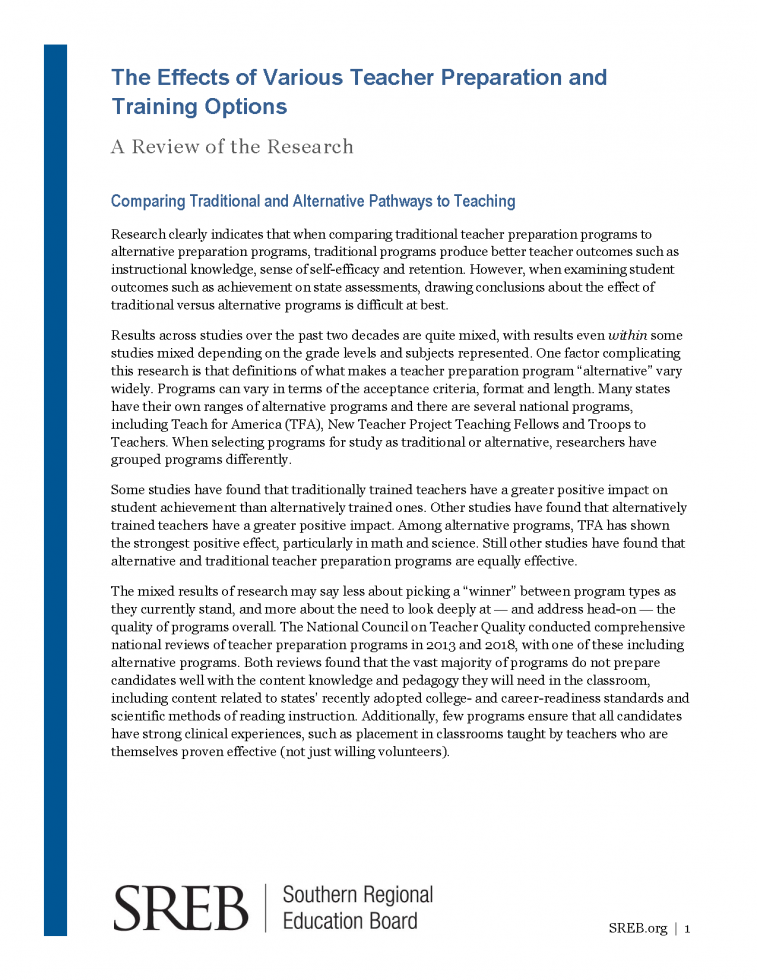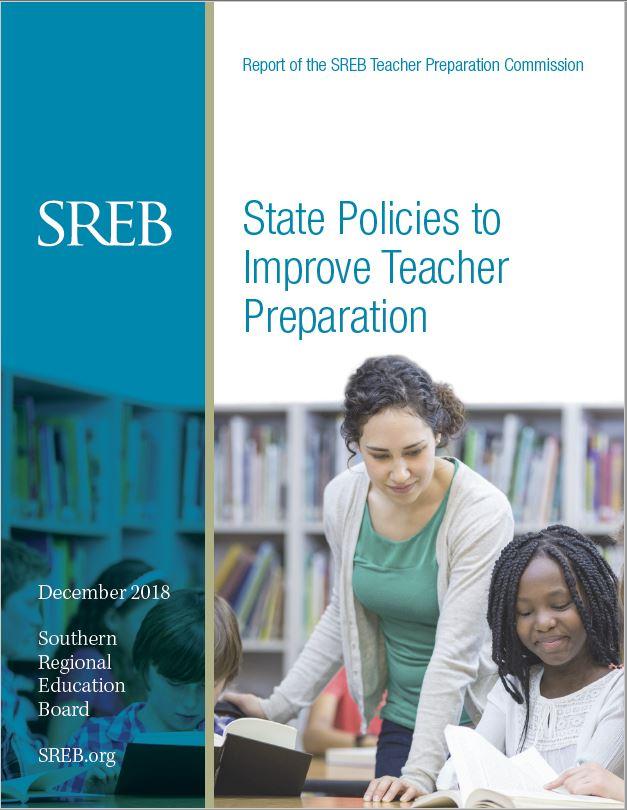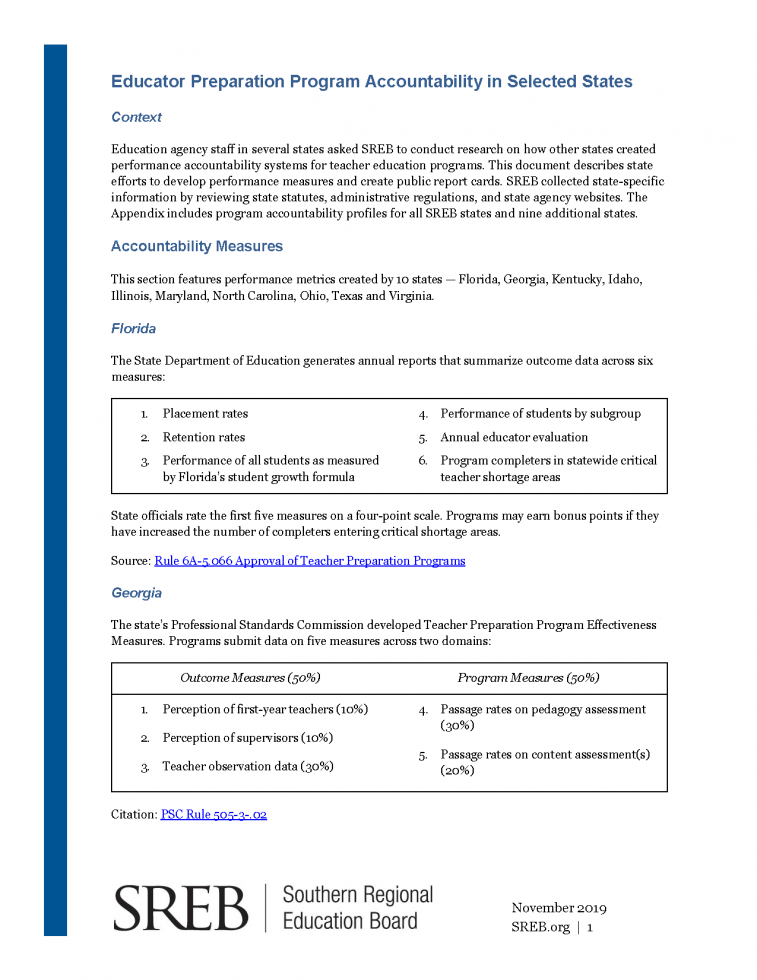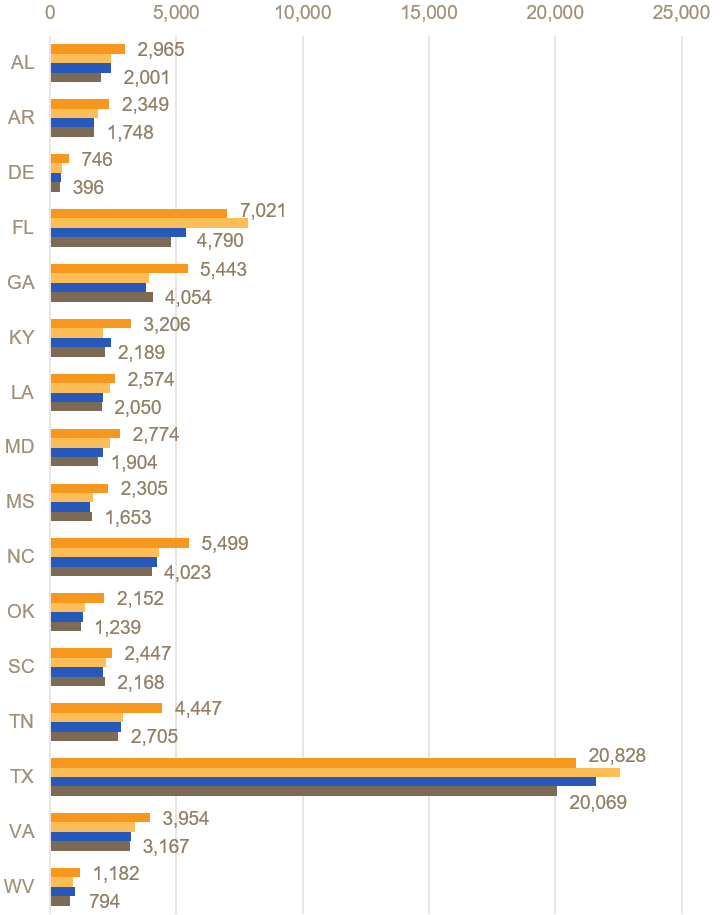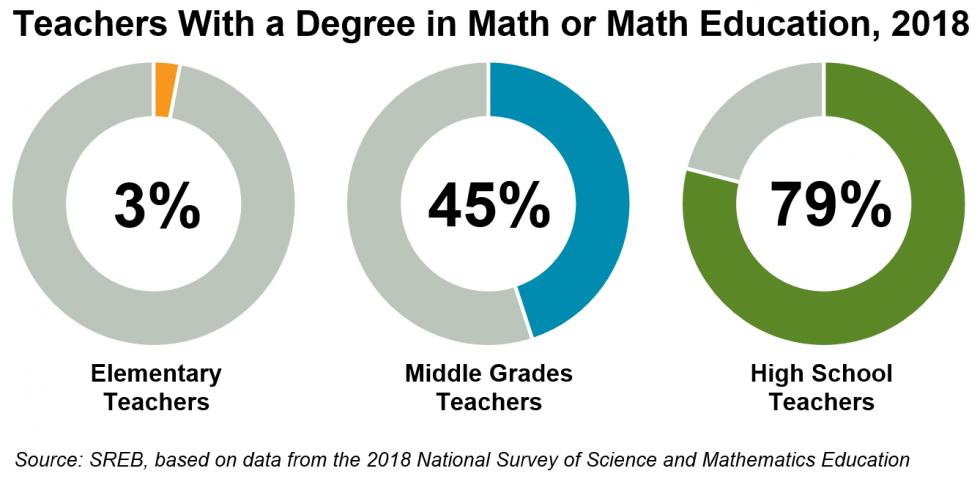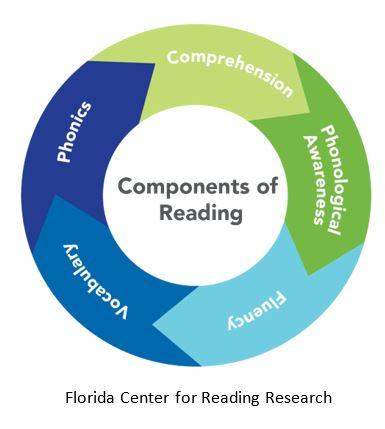Topic: Teacher Preparation
Teacher Preparation & Pathways
Every student deserves a well-prepared teacher. But states need numerous high-quality pathways into teaching to attract qualified and diverse candidates.
What do policies for strong teacher preparation pathways look like?
- Leverage an assortment of pathways into teaching — including traditional pathways, alternative programs, apprenticeships and residencies, and grow-your-own initiatives.
- Clearly outline a shared set of high standards and expectations for all pathways.
- Make sure that the content and pedagogy covered in preparation programs is attuned to the real-life needs teachers will face in the classroom, such as classroom management, the science of reading, and social-emotional learning.
- Offer a variety of options for teachers to prove their skills outside of tests and courses — for example, micro-credentials, classroom demonstrations, or edTPA.
- Collect data on the strengths and impact of new teachers to identify which programs and pathways the best teachers are coming from.
- Support teachers across the career continuum — for example, define pathways into teacher-leadership opportunities for educators who demonstrate success in the classroom and an ability to facilitate adults, and consider their role in preparing future teachers.
- Ensure that preparation pathways go hand-in-hand with other teacher workforce policies as part of a cohesive, interlocking system — for example, incentivize candidates to pursue the most effective pathways into teaching through a licensure system that allows for the best-prepared candidates to enter with a higher starting salary.
How SREB supports teacher preparation
SREB tracks and summarizes policies, analyzes research, and offers several programs to train, induct and mentor teachers.
SREB’s Teacher Preparation Commission met during 2016, 2017 and 2018 to develop practical and effective recommendations to improve teacher preparation across the region. Learn more and read the Commission’s most recent report by visiting our Teacher Preparation Commission page.
Investing Early in Teachers Pays Dividends for Everyone
In this post, we look at why investing early in teachers leads to great results for everyone involved. Through data and research, see how investing in teachers leads to things like higher retention.
What SREB’s Teacher Workforce Data Really Tells Us — And Why It Should Matter
In this post, we look at what the insights in SREB’s P-12 Educator Workforce Data portal actually mean. From examining the early childhood system strain to teacher shortages and more, reading this post will give you a better understanding into the current educator workforce.
Mentoring New Teachers
Invest in Educators Series
This guide provides support for mentors and outlines best practices for teacher induction using the SREB Teacher Induction Framework.
From Student to Teacher
How GYO Programs Foster Local Talent in Education
This brief was written by Joseph Tadlock, SREB director of research and evaluation, and Megan Boren, SREB director of educator workforce.
In this brief, we explore the different types of grow your own teacher programs, provide evidence of their effectiveness, and discuss how these programs could reshape new teacher induction.
How to Create Strong Teacher Induction
Effective induction programs are a key part of keeping great teachers. This post explores ways to create a strong induction program.
Why Teacher Induction Is the Missing Link in Ed Prep
And How CarolinaTIP Is Getting It Right
Teacher induction is an important part of school leadership, but it can be difficult to know how best to run your induction program. In this post, we look at how CarolinaTIP’s induction program is doing things so well.
From Preparation to Practice:
Early-Career Teacher Experiences in Three Southern States
The Southern Regional Education Board and partner researchers at Vanderbilt University conducted interviews with 30 new teachers in three states in fall 2024 as part of our third study together on the teacher workforce. This post features five novice teacher profiles to highlight the complexity of beginning teachers’ journeys from preparation to teacher-of-record. These profiles reinforce the study’s key findings on the need for new teachers to feel supported in their roles through a comprehensive system of support from preparation to placement to their first years in the classroom.
Pathways and Retention for New Teachers
Insights from Southern States
 Early-career teachers are entering the profession via an expanding variety of pathways. Do certain pathways provide more support than others? Do some entry routes into teaching yield higher rates of teacher retention? Why has early career teacher retention dipped so low and what can we do to change that?
Early-career teachers are entering the profession via an expanding variety of pathways. Do certain pathways provide more support than others? Do some entry routes into teaching yield higher rates of teacher retention? Why has early career teacher retention dipped so low and what can we do to change that?
A research partnership between SREB and Vanderbilt University explores these questions and more by analyzing state administrative data, survey results, and teacher interviews across three states in the South.
Teacher Career Pathways and Advancement Options
We need more high-quality pathways to ensure a skilled teacher workforce so that all students have prepared, certified teachers in every class. This report reviews the data on teacher shortages and quality and shows the four main pathways into the profession. It details the essential elements of quality teacher career pathways and offers examples to look toward from states around the nation.
How Modernizing Teaching Will Recruit More Educators
It’s no secret that fewer individuals are pursuing teaching as a career. SREB reports on this data annually. It’s on our minds so much so that SREB recently pursued research around this topic with Vanderbilt University to study teacher labor markets, Gen Z’s interest in the profession and their feedback on teacher working conditions.
Teacher Labor Market Trends
Insights From Two Southern States
Teacher shortages, high turnover rates and declining interest in the teaching profession have proven difficult for policymakers to address. These concerns are even more dire in Southern states.
Partnering with researchers at Vanderbilt University’s Peabody College of Education, SREB studied data in Kentucky and Tennessee on teacher labor market trends over the last decade. This online report features seven findings with interactive charts.
The Next Generation of Teachers
A Study of Generation Z’s Interest in the Teaching Profession
We depend on Generation Z to fill the growing number of teaching vacancies. Partnering with researchers at Vanderbilt University’s Peabody College of Education, SREB studied data in Kentucky and Tennessee for insight into Gen Z and their interest in the teaching profession. This online report features six findings with interactive charts.
Recruiting the Next Generation of Teachers: Challenges and Innovations
Crafting programs and policies that address the teacher workforce requires knowledge of Gen Z, their interest in entering the teaching profession, and how to support them as new teachers. In this brief, the research team reviewed the literature on Gen Z’s background, interest in teaching as a profession, and what states and districts are doing to try and recruit them.
State Policy Flexibilities in Response to COVID-19
Avoid Failing the Next Cohort of New Teachers
With colleges and schools moving online to curb the spread of COVID-19, state leaders will need to act quickly to ensure that policies do not prevent student-teachers from graduating and becoming licensed to teach in the fall. This brief includes immediate and longer-term recommendations to prevent pandemic closures from escalating the teacher shortage crisis.
The Effects of Teacher Preparation and Training Options
A Review of the Research
SREB reviewed research on the effects of various teacher preparation and training options. The brief includes a comparison of the impact on student achievement of traditional teacher preparation programs and alternative pathways. The report takes a look at how advanced degrees and certifications impact teacher effectiveness and retention.
State Policies to Improve Teacher Preparation
Report of the SREB Teacher Preparation Commission
To improve the effectiveness of new teachers, the SREB Teacher Preparation Commission called on states to:
How States Can Reduce College Debt for Future Teachers
 A major issue for my generation, the millennials, and for Gen Z as well is deep, suffocating student debt. For those who want to enter teaching, a career that is not compensated handsomely, this debt can be even more daunting.
A major issue for my generation, the millennials, and for Gen Z as well is deep, suffocating student debt. For those who want to enter teaching, a career that is not compensated handsomely, this debt can be even more daunting.
Many teacher candidates work full- or part-time jobs in addition to attending classes. When they enter their student teaching period, whether for a semester or a year, these candidates are expected to give over their time fully to student teaching, which makes working nearly impossible.
State Reading and Math Requirements for Elementary Teachers
SREB’s 2017 Ready to Read, Ready to Succeed and 2019 Early Math Matters reports explain the importance of well-prepared teachers in the elementary grades. These reports contain tables summarizing SREB states’ teacher preparation requirements in reading and math. The tables can be found below.
Educator Preparation Program Accountability in Selected States
SREB conducted research on how states create performance accountability systems for teacher education programs. This brief describes how states go about developing performance measures and creating public report cards. The document’s appendix includes program accountability profiles for all SREB states and nine additional states.
Teacher Preparation Program Completion
Total by State, 2012-13, 2016-17, 2017-18 and 2018-19
In the SREB region, nearly 15,000 fewer teacher candidates completed teacher preparation programs in 2019 than in 2013, and all SREB states saw overall declines in program completion in the last decade.
Top orange bar: 2012-13
Second yellow bar: 2016-17
Third blue bar bar: 2017-18
Bottom brown bar: 2018-19 (the most recent available data)
Using Data to Improve Teacher Preparation
Panelists from several states share their insights about how outcomes data and formative evidence collected during clinical experiences can improve teacher preparation. The SREB Teacher Preparation Commission recommended policymakers implement statewide data systems that prompt program leaders to transform practice.
Making Sense of Changes to Teacher Preparation and Licensure
SREB state legislators introduced over 4,600 education bills in 2019 regular sessions. At least 850 of these bills will become law, with roughly one hundred this year relating to teachers and principals. Here’s how seven notable bills align with SREB’s Teacher Preparation Commission recommendations.
Teacher Preparation Enrollment
By program type, traditional and alternative
Updated July 2019
Giving Elementary Teachers the Tools to Teach Math Well
Broad preparation can leave math-specific knowledge lacking
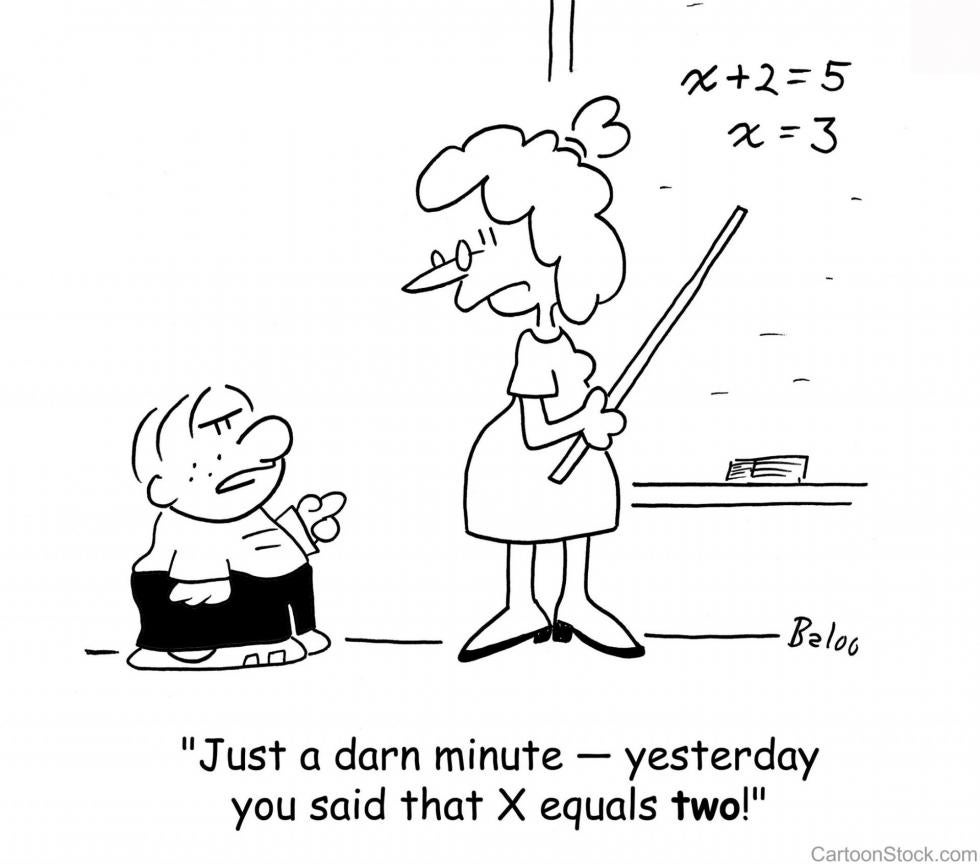 It’s no secret that aspiring
teachers with strong math backgrounds tend to be drawn toward the
secondary grades, where they can just teach math. In fact,
results of the 2018 National Survey of Science and Math
Education showed that just 3 percent of elementary teachers
surveyed held a degree in mathematics or math education, compared
with 45 percent of middle grades math teachers and 79 percent of
high school math teachers.
It’s no secret that aspiring
teachers with strong math backgrounds tend to be drawn toward the
secondary grades, where they can just teach math. In fact,
results of the 2018 National Survey of Science and Math
Education showed that just 3 percent of elementary teachers
surveyed held a degree in mathematics or math education, compared
with 45 percent of middle grades math teachers and 79 percent of
high school math teachers.
Spotlight on Clinical Experiences
How State Leaders Could Support High-Quality Clinical Practice
The SREB Teacher Preparation Commission called on state leaders to consider ways to improve the quality of teacher candidates’ classroom experiences. After consulting the research, Commission members learned that the length of a clinical experience is less important than ensuring that candidates are supported by effective mentors and supervised by university faculty who have experience in the classroom.
Getting the Balance Right
Reconsidering the Mix of Teacher Licensure Measures
The SREB Teacher Preparation Commission called on state leaders to adopt practice-based assessments. These tests assess candidates’ readiness to lead a classroom and to apply lessons learned during coursework and clinical experiences.
Practice-based assessments have diagnostic value, meaning they provide performance data that educator preparation programs can use to identify strengths and opportunities for improvement. State agencies could use the assessment data to determine how they will provide technical assistance to preparation programs.
Are teachers prepared to teach reading?
Research shows a gap between what we know about reading and how teachers are prepared to teach it
Reading is the foundation for learning.
The research is clear: Students who are not reading proficiently by the end of third grade are much more likely to face poor academic outcomes. For this reason alone, we know it is incredibly important that children learn to read well early in elementary school and continue to build on those reading skills throughout the rest of school.











